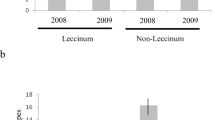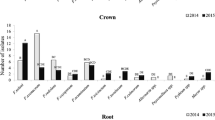Abstract
Quantitative polymerase chain reaction (qPCR) was used to assess the abundance and relative distribution of host infection groups of the root-nodule forming, nitrogen-fixing actinomycete Frankia in four soils with similar physicochemical characteristics, two of which were vegetated with a host plant, Alnus glutinosa, and two with a non-host plant, Betula nigra. Analyses of DAPI-stained cells at three locations, i.e., at a distance of less than 1 m (near stem), 2.5 m (middle crown), and 3–5 m (crown edge) from the stems of both tree species revealed no statistically significant differences in abundance. Frankiae generally accounted for 0.01 to 0.04 % of these cells, with values between 4 and 36 × 105 cells (g soil)−1. In three out of four soils, abundance of frankiae was significantly higher at locations “near stem” and/or “middle crown” compared to “crown edge,” while numbers at these locations were not different in the fourth soil. Frankiae of the Alnus host infection group were dominant in all samples accounting for about 75 % and more of the cells, with no obvious differences with distance to stem. In three of the soils, all of these cells were represented by strain Ag45/Mut15. In the fourth soil that was vegetated with older A. glutinosa trees, about half of these cells belonged to a different subgroup represented by strain ArI3. In all soils, the remaining cells belonged to the Elaeagnus host infection group represented by strain EAN1pec. Casuarina-infective frankiae were not found. Abundance and relative distribution of Frankia host infection groups were similar in soils under the host plant A. glutinosa and the non-host plant B. nigra. Results did thus not reveal any specific effects of plant species on soil Frankia populations.

Similar content being viewed by others
References
Schwintzer CR, Tjepkema JD (1990) The biology of Frankia and actinorhizal plants. Academic, San Diego
Huss-Danell K (1997) Actinorhizal symbioses and their N-2 fixation. New Phytol 136:375–405
Benson DR, Silvester WB (1993) Biology of Frankia strains, actinomycete symbionts of actinorhizal plants. Microbiol Rev 57:293–319
Benson DR, Dawson J (2007) Recent advances in the biogeography and genecology of symbiotic Frankia and its host plants. Physiol Plant 130:318–330
Baker DD (1987) Relationships among pure cultured strains of Frankia based on host specificity. Physiol Plant 70:245–248
Wolters DJ, Van Dijk C, Zoetendal EG, Akkermans AD (1997) Phylogenetic characterization of ineffective Frankia in Alnus glutinosa (L.) Gaertn. nodules from wetland soil inoculants. Mol Ecol 6:971–981
Smolander A (1990) Frankia populations in soils under different tree species—with special emphasis on soils under Betula pendula. Plant Soil 121:1–10
Rönkkö R, Smolander A, Nurmiaho-Lassila EL, Haahtela K (1993) Frankia in the rhizosphere of nonhost plants: a comparison with root-associated nitrogen-fixing Enterobacter, Klebsiella and Pseudomonas. Plant Soil 153:85–95
Mirza BS, Welsh A, Hahn D (2007) Saprophytic growth of inoculated Frankia sp. in soil microcosms. FEMS Microbiol Ecol 62:280–289
Mirza BS, Welsh A, Hahn D (2009) Growth of Frankia strains in leaf litter-amended soil and the rhizosphere of a nonactinorhizal plant. FEMS Microbiol Ecol 70:132–141
Nickel A, Pelz O, Hahn D, Saurer M, Siegwolf R, Zeyer J (2001) Effect of inoculation and leaf litter amendment on establishment of nodule-forming Frankia populations in soil. Appl Environ Microbiol 67:2603–2609
Cournoyer B, Gouy M, Normand P (1993) Molecular phylogeny of the symbiotic actinomycetes of the genus Frankia matches host-plant infection processes. Mol Biol Evol 10:1303–1316
Normand P, Orso S, Cournoyer B, Jeannin P, Chapelon C, Dawson J, Evtushenko L, Misra AK (1996) Molecular phylogeny of the genus Frankia and related genera and emendation of the family Frankiaceae. Int J Syst Bacteriol 46:1–9
Zimpfer JE, Kennedy GJ, Smyth CA, Hamelin J, Navarro E, Dawson JO (1999) Localization of Casuarina-infective Frankia near Casuarina cunninghamiana trees in Jamaica. Can J Bot 77:1248–1256
Paschke MW, Dawson JO (1992) Frankia abundance in soils beneath Betula nigra and other non-actinorhizal woody plants. Acta Oecol 13:407–415
Smolander A, Sarsa ML (1990) Frankia strains of soil under Betula pendula: behaviour in soil and in pure culture. Plant Soil 122:129–136
Markham JH, Chanway CP (1996) Alnus rubra nodulation of soil under five species from harvested forest sites in coastal British Columbia. Plant Soil 178:283–286
Myrold DD, Hilger AB, Huss-Danell K, Martin KJ (1994) Use of molecular methods to enumerate Frankia in soil. In: Ritz K, Dighton J, Giller KE (eds) Beyond the biomass. John Wiley & Sons, Chichester, pp 127–136
Samant S, Amann RI, Hahn D (2014) Evaluation of the 23S rRNA gene as target for qPCR based quantification of Frankia in soils. Syst Appl Microbiol 37:229–234
Samant S, Sha Q, Iyer A, Dhabekar P, Hahn D (2012) Quantification of Frankia in soils using SYBR Green based qPCR. Syst Appl Microbiol 35:191–197
Klindworth A, Pruesse E, Schweer T, Peplies J, Quast C, Horn M, Glöckner F-O (2012) Evaluation of general 16S ribosomal RNA gene PCR primers for classical and next-generation sequencing-based diversity studies. Nucleic Acids Res. doi:10.1093/nar/gks1808
Quast C, Pruesse E, Yilmaz P, Gerken J, Schweer T, Yarza P, Peplies J, Glöckner F-O (2012) The SILVA ribosomal RNA gene database project: improved data processing and web-based tools. Nucleic Acids Res. doi:10.1093/nar/gks1219
Sha Q, Forstner MRJ, Bonner T, Hahn D (2013) Salmonellae in fish feces analyzed by in situ hybridization and quantitative polymerase chain reaction. J Aquat Anim Health 25:184–190
Zarda B, Hahn D, Chatzinotas A, Schönhuber W, Neef A, Amann RI, Zeyer J (1997) Analysis of bacterial community structure in bulk soil by in situ hybridization. Arch Microbiol 168:185–192
Chatzinotas A, Sandaa R-A, Schönhuber W, Amann RI, Daae LF, Torsvik V, Zeyer J, Hahn D (1998) Analysis of broad-scale differences in microbial communities of two pristine forest soils. Syst Appl Microbiol 21:579–587
Manlaya RJ, Fellerc C, Swift MJ (2007) Historical evolution of soil organic matter concepts and their relationships with the fertility and sustainability of cropping systems. Agric Ecosyst Environ 119:217–233
Picard C, Ponsonnet C, Paget E, Nesme X, Simonet P (1992) Detection and enumeration of bacteria in soil by direct DNA extraction and polymerase chain reaction. Appl Environ Microbiol 58:2717–2722
Hahn D, Kester R, Starrenburg MJC, Akkermans ADL (1990) Extraction of ribosomal RNA from soil for detection of Frankia with oligonucleotide probes. Arch Microbiol 154:329–335
Myrold DD, Huss-Danell K (1994) Population dynamics of Alnus-infective Frankia in a forest soil with and without host trees. Soil Biol Biochem 26:533–540
Maunuksela L, Zepp K, Koivula T, Zeyer J, Haahtela K, Hahn D (1999) Analysis of Frankia populations in three soils devoid of actinorhizal plants. FEMS Microbiol Ecol 28:11–21
Nickel A, Hahn D, Zepp K, Zeyer J (1999) In situ analysis of introduced Frankia populations in root nodules of Alnus glutinosa grown under different water availability. Can J Bot 77:1231–1238
Zimpfer JF, Smyth CA, Dawson JO (1997) The capacity of Jamaican mine spoils, agricultural and forest soils to nodulate Myrica cerifera, Leucaena leucocephala and Casuarina cunninghamiana. Physiol Plant 99:664–672
Diem HG, Dommergues YR (1990) Current and potential uses and management of Casuarinaceae in the tropics and subtropics. In: Schwintzer CR, Tjepkema JD (eds) The biology of Frankia and actinorhizal plants. Academic, San Diego, pp 365–385
Paschke MW, Dawson JO (1993) Avian dispersal of Frankia. Can J Bot 71:1128–1131
Acknowledgments
The authors are indebted to the Office of Sponsored Programs (Research Enhancement Program Grant No. 9000000647), the Graduate College (Doctoral Research Support Fellowship to S. Samant), and the Department of Biology at Texas State University for the financial support.
Author information
Authors and Affiliations
Corresponding author
Rights and permissions
About this article
Cite this article
Samant, S., Huo, T., Dawson, J.O. et al. Abundance and Relative Distribution of Frankia Host Infection Groups Under Actinorhizal Alnus glutinosa and Non-actinorhizal Betula nigra Trees. Microb Ecol 71, 473–481 (2016). https://doi.org/10.1007/s00248-015-0643-2
Received:
Accepted:
Published:
Issue Date:
DOI: https://doi.org/10.1007/s00248-015-0643-2




